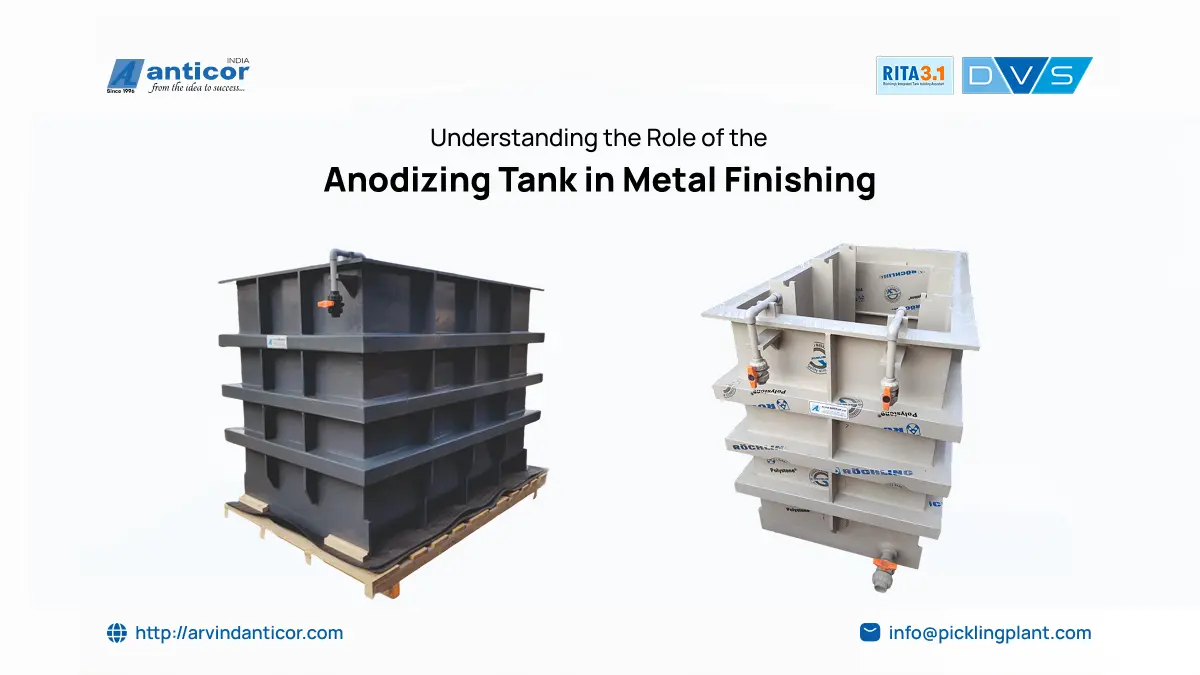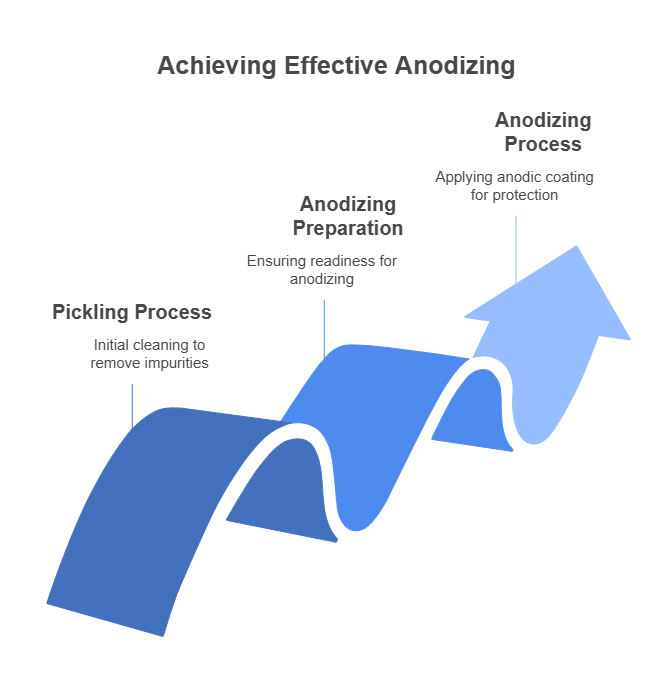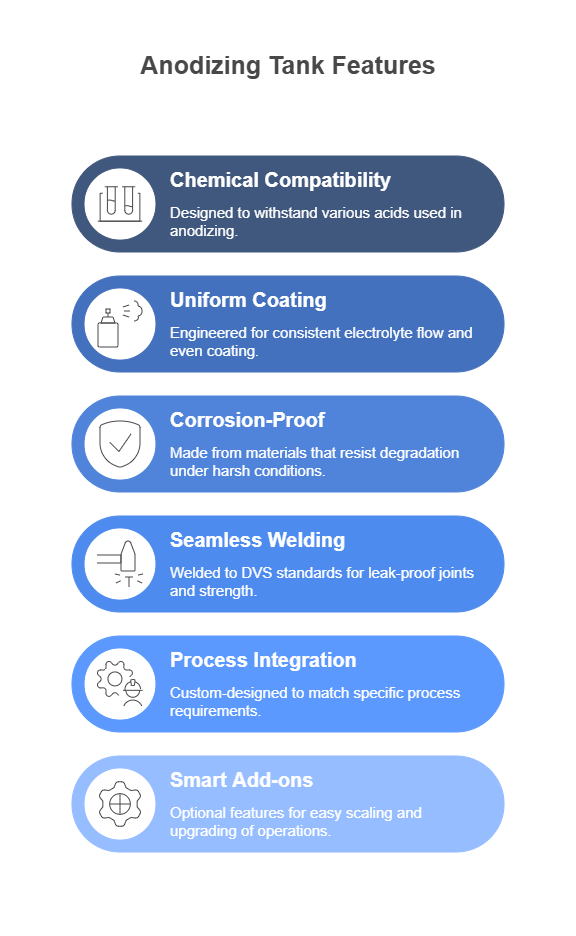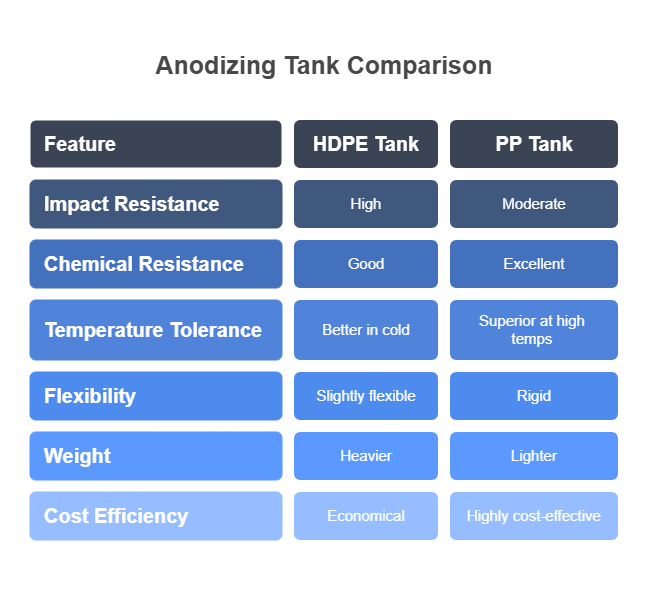

The anodizing process is one of the most effective ways to improve the corrosion resistance, wear resistance, and look of metals, particularly aluminium. The anodizing tank is a vital but frequently overlooked component of this process—a specially built container that promotes the chemical processes required to anodize metal.
At Arvind Anticor, we build and manufacture cutting-edge anodizing tanks that provide precision, durability, and safety throughout surface treatment operations.
What is an Anodizing Tank and Why Is It Important?
An anodizing tank is a chemically resistant container used to hold acids and electrolytes while metal components are submerged. These tanks are crucial for preparing, treating, and finishing anodized metal surfaces.
Prior to anodizing, metal parts are often cleaned with a pickling procedure, which removes oxides and impurities from the surface. Depending on the process arrangement, the same anodizing tank is frequently used or combined with a separate pickling tank.

Materials Used in Anodizing Tanks
Since anodizing uses extremely corrosive chemicals like nitric and sulfuric acids, it’s critical to construct the anodizing tank using materials that provide:
- High chemical resistance
- Thermal stability
- Mechanical strength
At Arvind Anticor, we offer anodizing tanks made from:
- Polypropylene (PP) – Known for excellent acid resistance.
- High-Density Polyethylene (HDPE) – Tough and durable under continuous use.
- Fiber-Reinforced Plastic (FRP) – Ideal for high-stress and custom-designed tanks.
At Arvind Anticor, we offer anodizing tanks made from Polypropylene (PP), High-Density Polyethylene (HDPE), and FRP. To explore why these materials are ideal, check out our blog on pickling tank materials where we compare PP and FRP in detail.
Key Features of Arvind Anticor’s Anodizing Tanks
Our anodizing tanks are designed to last in industrial settings while providing performance, efficiency, and longevity. What distinguishes them is this:
- Better Chemical Compatibility
Made to resist typical electrolytes and acids used in the anodizing process, including as phosphoric, chromic, and sulfuric acid.
- Specifically Designed for Even Coating
Designed with optimal shape and steady electrolyte flow to provide uniform metal coating and reduced chemical waste.
- Construction That Is Corrosion-Proof
Made with materials that don’t break down over time, even when subjected to high loads and temperatures, such as PP, HDPE, or FRP.
- Making Use of DVS Technology for Seamless Welding
To ensure leak-proof seams and increased mechanical strength, all tanks are welded in accordance with DVS (German Welding Society) standards.
- Specifically Designed for Process Integration
RITA 3.1 software is used to create each anodizing tank specifically tailored to your process layout, load requirements, and volume requirements.
- Easily expandable with clever add-ons
Fume extraction, agitation systems, and overflow sections are examples of optional features that make it simple to expand or improve your business.

For clients considering polypropylene for their anodizing setup, our dedicated blog on polypropylene tanks explains its chemical resistance and long-term performance in demanding industrial environments.
Why Choosing the Right Anodizing Tank Matters
There are several advantages to having a top-notch anodizing tank for your whole surface treatment business:
- The outcome of constant chemical exposure is uniform coating.
- lower maintenance because to the construction’s resistance to corrosion
- Reduced chemical usage because of improved tank geometry
- Extended lifespan and reduced likelihood of leakage or deformation
Selecting the appropriate anodizing tank has a quantifiable impact on output quality and operational efficiency, regardless of whether you’re operating a small anodizing process unit or a large finishing facility. measurable difference in output quality and operational efficiency.
HDPE vs PP Anodizing Tank: Which is Right for You?
Depending on your production circumstances, you can choose between HDPE and PP. Here is a comparison between the two:
The operational and environmental circumstances of your plant should be taken into account when choosing between HDPE and PP for your anodizing tank. Because of its excellent impact resistance and somewhat flexible character, HDPE is a good choice for applications that may involve frequent handling or mechanical stress. It works well in lower temperature settings and is reasonably priced.
On the other hand, PP has good chemical resistance, particularly against the strong acids frequently used in the anodizing process. Additionally, it can withstand greater temperatures better and maintains its shape and rigidity over time. PP is frequently the material of choice for operations needing exceptional resistance to heat and corrosive chemicals.
At Arvind Anticor, we evaluate your specific application to help you select the right material that balances durability, performance, and cost-efficiency.

In order to suggest the best material for your anodizing tank, we at Arvind Anticor assist you in evaluating your operating characteristics and application requirements.
Arvind Anticor: Your Partner in High-Performance Anodizing Tanks
With over two decades of experience in designing industrial process tanks, Arvind Anticor is a trusted name in providing anodizing tank solutions for global clients.
We offer:
- Turnkey anodizing tank systems
- Fast project delivery timelines
- Expert consultation for setup and optimization
📩 Reach out to us at [email protected] or [email protected] to discuss your anodizing tank requirements.
Final Thoughts on Anodizing Tanks
The quality and dependability of your anodizing tank have a major impact on the outcome of your anodizing operation. In addition to guaranteeing excellent surface finishing, the proper engineering, materials, and design can also boost plant efficiency and safety.
Let Arvind Anticor help you build a better, more durable anodizing system—starting with the right anodizing tank.
Let’s Connect
Contact Us
We are live 24/7 and reply within 48 hours.
Get in Touch
-
-
-
Address
Survey No.584/1+2 – C,Nr. Akshar Industrial Estate Mahemdabad Highway Road,Vatva Ahmedabad-382445, Gujarat, India.